Year 10+ Plane Geometry
Chapters
Areas of Compound Shapes
Areas of Compound Shapes
Compound shapes are made up of two or more simple shapes. The area of a flat shape is the amount of space it takes up. In other words, it is the size of a surface.
Let's start by recalling the formulas for the areas of some plane shapes, and then look at a few examples of how these may be combined to find the areas of compound shapes.
Area Formulas for Simple Shapes
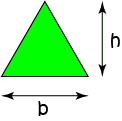
Triangle
\(\text{Area} = \dfrac{1}{2} \times b \times h\)
\(b\) is the length of the base, and \(h\) is the height of the triangle.

Square
\(\text{Area} = s^2\)
\(s\) is the side-length of the square.
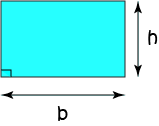
Rectangle
\(\text{Area} = b \times h\)
\(b\) is the base (or length) of the rectangle.
\(h\) is the height of the rectangle.
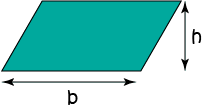
Parallelogram
\(\text{Area} = b \times h\)
\(b\) is the base (or length) of the parallelogram.
\(h\) is the height of the parallelogram.
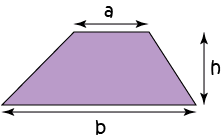
Trapezium
\(\text{Area} = \dfrac{1}{2}(a + b) \times h\)
\(a\) and \(b\) are the parallel sides of the trapezium.
\(h\) is the height of the trapezium.
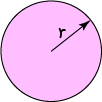
Circle
\(\text{Area} = \pi r^2\)
\(r\) is the radius of the circle.

Sector
\(\text{Area} = \dfrac{1}{2} \times r^2 \times \theta\)
Note: for this to work, the angle must be measured in radians
Here, \(r\) is the radius and \(\theta\) is the angle at the centre, in radians.

Ellipse
\(\text{Area} = \pi ab\)
\(a\) and \(b\) are half the lengths of the axes of the ellipse.
Note: In the above, the height is always perpendicular to the base of the shape.
Example 1
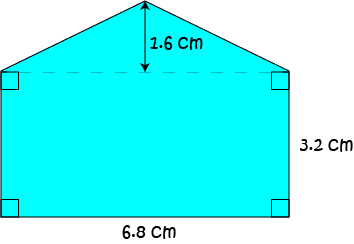
What is the area of the region that is coloured blue in the picture?
Solution:
This compound shape is made up of a rectangle of base-length 6.8 cm and height 3.2 cm, and a triangle of base-length 6.8 cm and height 1.6 cm. Its area is
Example 2
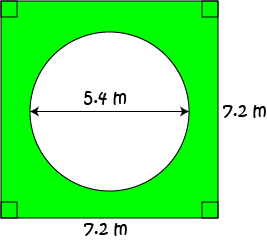
What is the area of the region that is coloured green in the picture?
Solution:
This compound shape is made up of a square of side-length 7.2 m from which a circle of diameter 5.4 m has been cut out. The radius of the circle is \(r = 5.4 \div 2 = 2.7 \text{ m}\). Its area is
Example 3
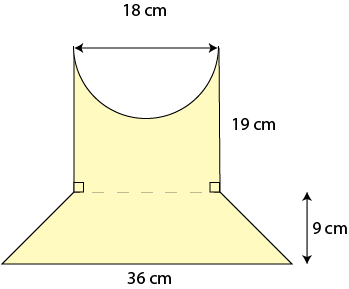
What is the area of the region that is coloured yellow in the picture?
Solution:
This compound shape is made up of a rectangle of side-lengths 19 cm and 18 cm from which a semicircle of diameter 18 cm has been cut out, together with a trapezium of parallel side-lengths 36 cm and 18 cm, and height 9 cm. The radius of the semicircle is \(r = 18 \div 2 = 9 \text{ cm}\). Its area is
One Last Example
Sam has a part-time job, mowing the oval-shaped park shown below.
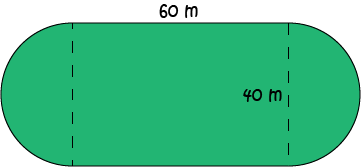
If he is paid \(\$0.02\) per square metre mown, how much does he earn each time he mows the park?
Solution: We need to find the area of the oval in square metres and multiply it by \(\$0.02\) to find Sam's earnings.
The oval is made up of two straight sides of length \(60\) m, and two semi-circles of radius \(\dfrac{1}{2}(40) = 20 \text{ m}\). So, its area is equal to the area of a circle of radius \(20\) m, plus the area of a rectangle with base length \(60\) m and height \(40\) m:
So, Sam is paid
Description
In these chapters you will learn about plane geometry topics such as
- Area (Irregular polygons, plane shapes etc)
- Perimeter
- Conic sections (Circle, Ellipse, Hyperbola etc)
- Polygons (Congruent, polygons, similar, triangles etc)
- Transformations and symmetry (Reflection, symmetry, transformations etc)
etc
Even though these chapters are marked for Year 10 or higher students, several topics are for students in Year 8 or higher
Audience
Year 10 or higher, suitable for Year 8 + students as well.
Learning Objectives
Learn about Plane Geometry
Author: Subject Coach
Added on: 28th Sep 2018
You must be logged in as Student to ask a Question.
None just yet!